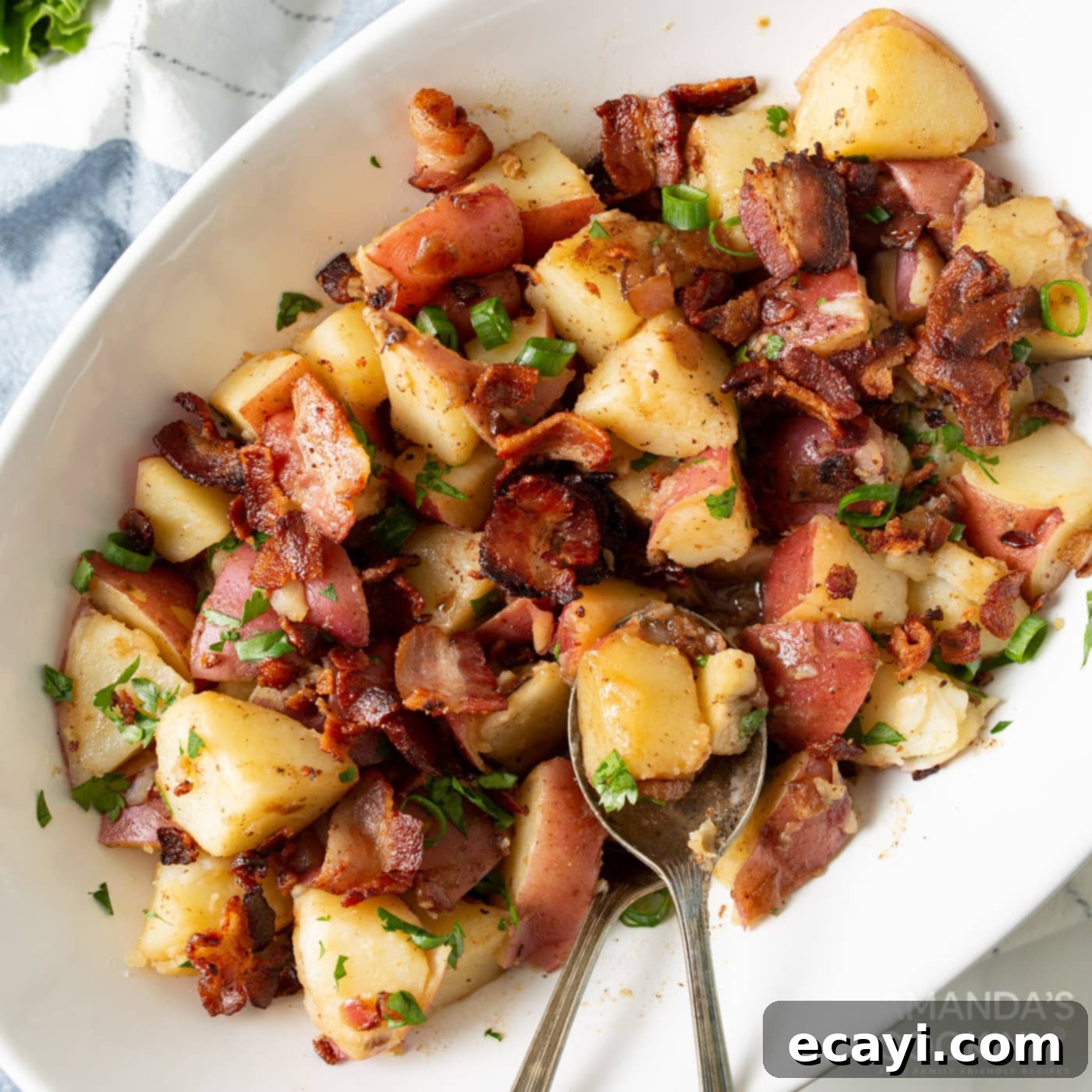Authentic German Potato Salad: A Warm, Savory, and Tangy Classic with Bacon
Dive into the rich flavors of a truly authentic German Potato Salad. Unlike its mayonnaise-based American cousin, this delightful side dish features fork-tender red potatoes coated in a vibrant, tangy, and savory dressing made with crisp bacon, purple onions, and a zesty vinegar blend. Perfect served warm or at room temperature, it’s a versatile recipe bursting with flavor that will elevate any meal, from backyard barbecues to festive holiday gatherings.
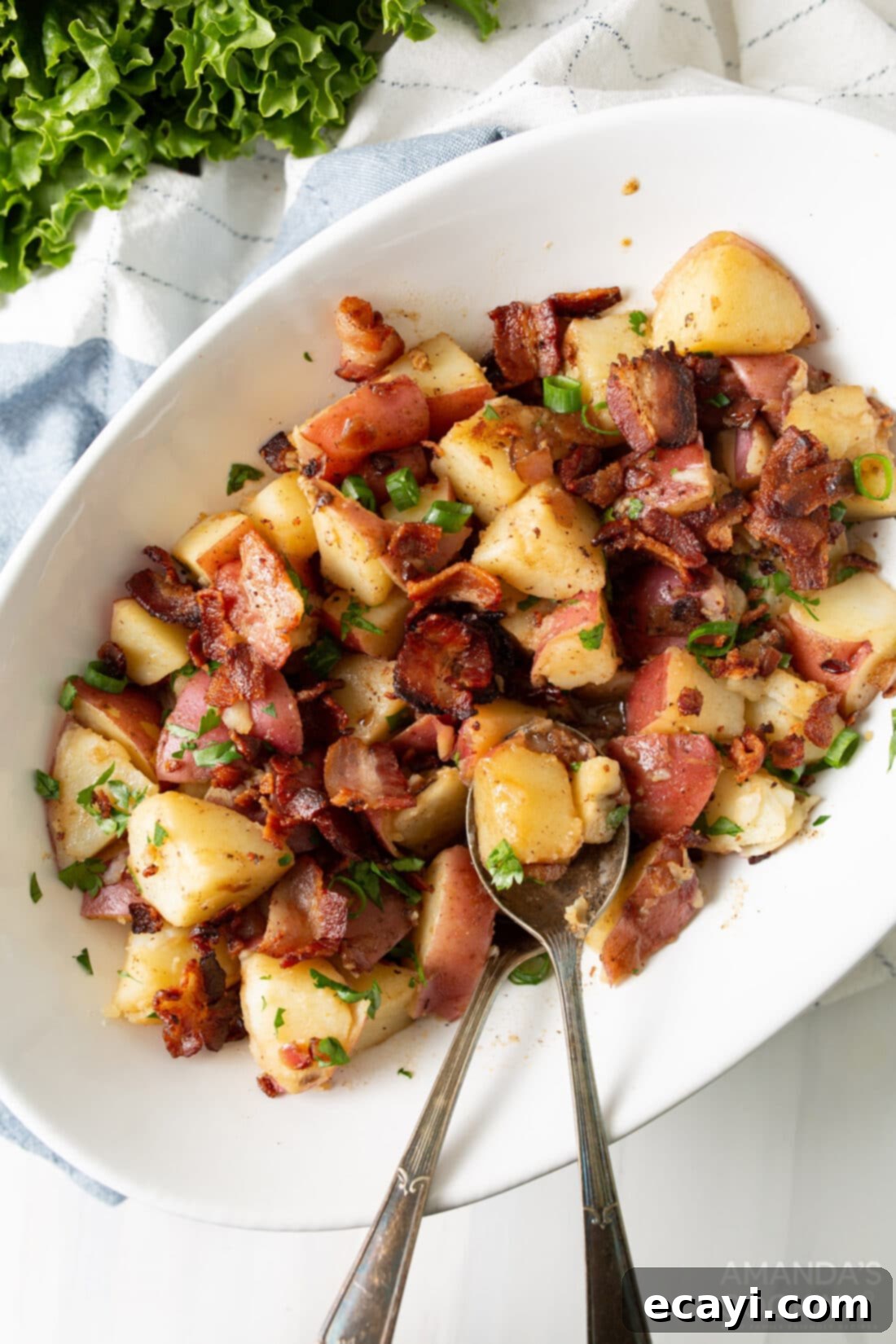
Why This German Potato Salad Recipe is a Must-Try
This traditional German potato salad recipe stands out for its unique blend of flavors and textures, making it a delicious departure from typical potato salads. It masterfully combines the earthy sweetness of red potatoes with the sharp tang of apple cider vinegar, the savory crunch of bacon, and the aromatic depth of purple onion and garlic. The result is a zesty, highly flavorful potato dish that’s both comforting and invigorating, promising a culinary experience you won’t want to miss.
While many in the United States associate potato salad with a cold, creamy, mayonnaise or mustard-based dressing, the origins of potato salad are widely believed to lie in Germany. Over time, different regions and cultures have adapted the concept, leading to diverse interpretations. The German style, however, remains true to a warm, vinegar-based dressing, often highlighted by bacon. This warm potato salad is an incredible accompaniment to a wide range of main courses, offering a refreshing and bold counterpoint to richer meats or a hearty complement to lighter fare. Its versatility means it can be enjoyed freshly made and warm, or as delicious leftovers straight from the refrigerator, showcasing its enduring appeal and robust flavor profile.
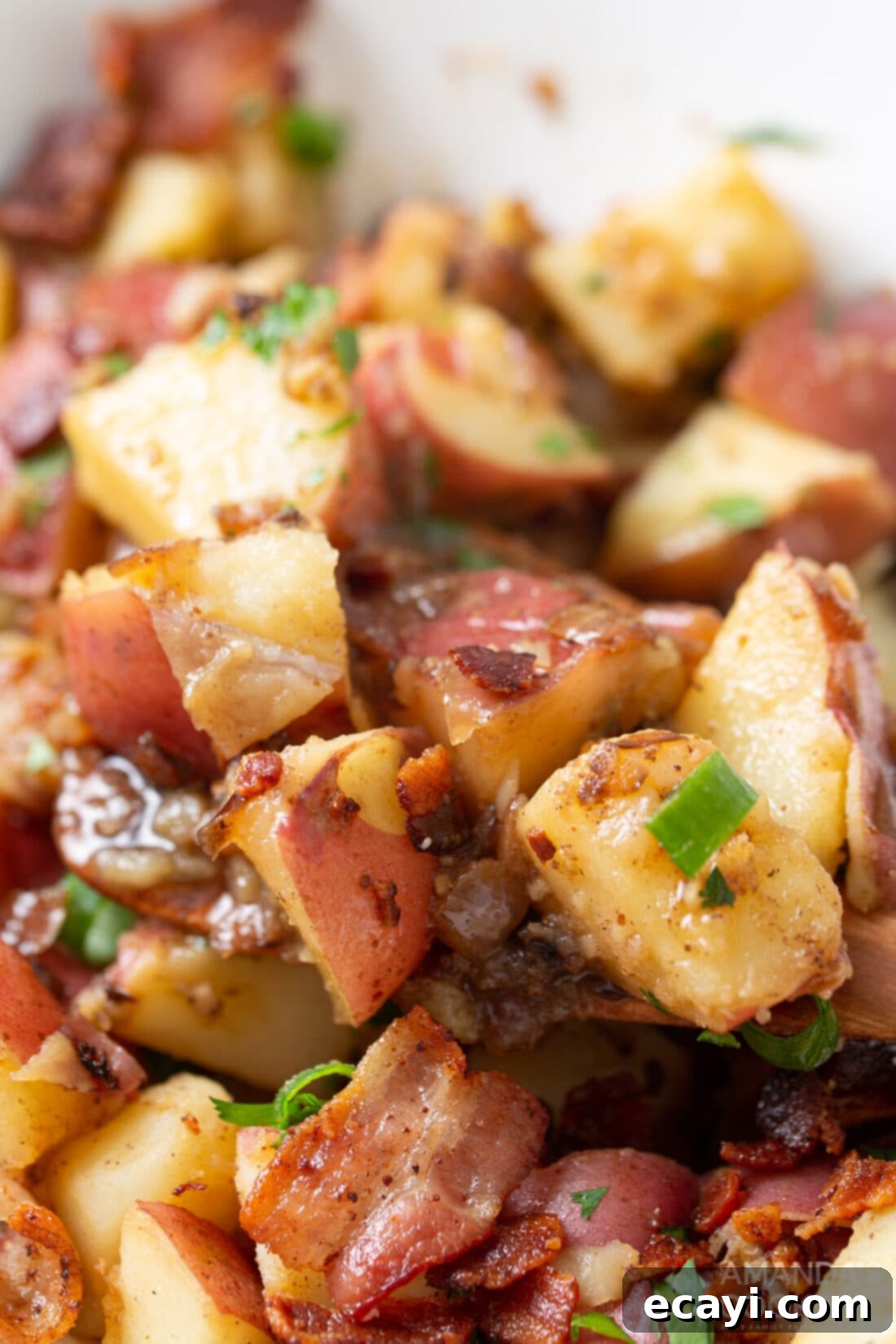
Key Ingredients for Your German Potato Salad
Crafting the perfect German potato salad starts with selecting the right ingredients. Each component plays a vital role in achieving that authentic, irresistible flavor. Below, you’ll find a detailed list of what you’ll need, along with helpful information and substitution suggestions to ensure your dish is a resounding success. For precise measurements and step-by-step instructions, refer to the printable recipe card located at the end of this post.
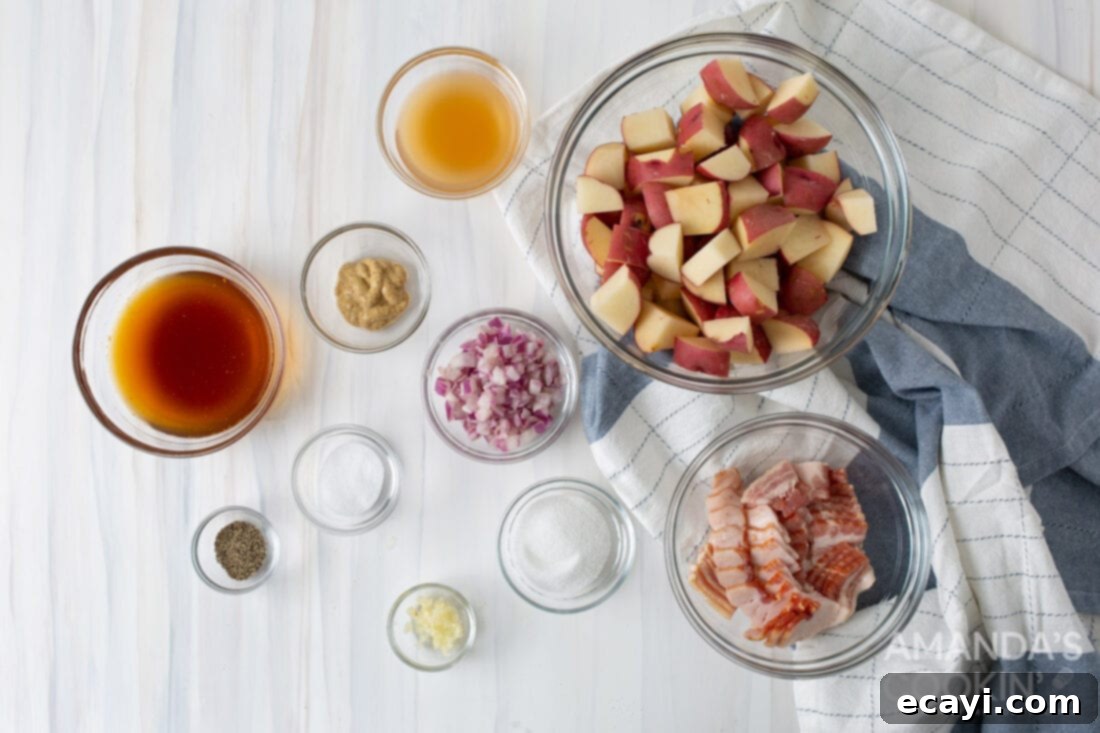
Ingredient Spotlight & Smart Substitutions
Understanding each ingredient’s role is key to mastering this classic German dish. Here’s a closer look at what makes this recipe shine, along with some flexible options:
POTATOES – The foundation of any great potato salad. For this German potato salad, waxy potatoes are ideal as they hold their shape well after cooking and absorb the dressing beautifully without becoming mushy. Baby red potatoes or larger red potatoes are both excellent choices. When using larger red potatoes, simply halve them and then cut into three equal pieces to create uniform, bite-sized chunks. Yukon Gold potatoes also make a fantastic substitute due to their slightly waxy texture and buttery flavor. Always cook your potatoes until they are fork-tender but still firm enough to retain their structure.
DRESSING – The heart and soul of this savory potato salad. Its distinct flavor profile is built upon a harmonious blend of bacon fat, apple cider vinegar, Dijon mustard, and beef broth, balanced with a touch of sugar and aromatics.
- Bacon Fat: Do not discard the rendered bacon fat! This is essential for building the rich, smoky base of the dressing. It’s what gives German potato salad its signature depth of flavor.
- Apple Cider Vinegar: Provides the characteristic tangy zest. If you don’t have apple cider vinegar, white vinegar can be used as a one-to-one substitute, but be mindful that white vinegar is typically stronger in flavor. You may want to start with a slightly smaller amount and adjust to taste. White wine vinegar is another good alternative, offering a slightly milder acidity.
- Dijon Mustard: Adds a pungent, slightly spicy kick and helps to emulsify the dressing, creating a more cohesive flavor. Whole grain Dijon can also be used for a textural element.
- Beef Broth: Contributes savory depth to the dressing. If beef broth isn’t available, chicken broth or even vegetable broth can be used in a pinch, though they may alter the final flavor profile slightly.
- Garlic: This recipe includes minced garlic for an extra layer of aromatic flavor. For a more traditional German potato salad, some recipes omit garlic, focusing purely on onion and bacon. Feel free to adjust based on your preference.
- Sugar: A crucial ingredient that balances the acidity of the vinegar, preventing the dressing from being overly sharp and creating a well-rounded sweet and sour profile.
GARNISH & SEASONING – Fresh parsley or chives add a burst of color and fresh herbaceous notes, complementing the savory flavors beautifully. Don’t forget to season generously with salt and pepper to taste before serving.
Step-by-Step Guide: How to Make German Potato Salad
These step-by-step photos and detailed instructions are here to help you visualize how to make this delicious recipe. For a quick jump to the printable version, complete with precise measurements and instructions, simply Jump to Recipe at the bottom of the page.
- Prepare and Cook the Potatoes: Begin by washing your red potatoes thoroughly. If you’re using baby red potatoes, simply quarter them, leaving the skin on for extra flavor and nutrients. For large red potatoes, halve each one, then cut each half into three equal pieces, aiming for uniformly sized chunks. Place the prepared potatoes in a large pot and cover with cold water. Add a generous pinch of salt to the water. Bring to a boil, then reduce heat and simmer for 15-20 minutes, or until the potatoes are fork-tender but not mushy. It’s crucial they maintain some firmness to avoid a crumbly salad. Drain the potatoes well and set them aside.
- Crisp the Bacon and Sauté Aromatics: While the potatoes are cooking, use a large skillet over medium heat to fry the bacon pieces until they are wonderfully crispy. This usually takes about 5-7 minutes. Once cooked, transfer the crispy bacon to a plate lined with paper towels to drain, reserving the flavorful bacon grease in the skillet. Keep about two tablespoons of bacon grease in the pan – this forms the crucial base for our dressing. Add the diced purple onion to the skillet with the rendered bacon fat and cook for about 2 minutes, stirring occasionally, until it begins to soften and become translucent. Then, add the minced garlic and stir for another 30 seconds until fragrant. Be careful not to burn the garlic.
- Craft the Tangy Dressing: Pour the apple cider vinegar, beef broth, Dijon mustard, and sugar into the hot skillet with the onions and garlic. Stir well to combine all the ingredients, scraping up any browned bits from the bottom of the pan – these are packed with flavor!
- Simmer and Combine: Bring the dressing mixture to a gentle simmer and let it cook for about 7 minutes. This simmering time allows the flavors to meld beautifully and the dressing to reduce slightly, intensifying its taste. Once simmered, remove the skillet from the heat. Add the cooked, drained potatoes to the skillet with the warm dressing. Gently toss everything together, ensuring the potatoes are thoroughly coated with the savory and tangy dressing. The warmth of the potatoes will help them absorb the flavors even better.
- Garnish and Serve: Transfer the German potato salad to a serving bowl. Crumble the reserved crispy bacon pieces over the top. For an added touch of freshness and color, sprinkle with chopped fresh parsley and/or chives. Taste and season with additional salt and pepper as needed. Serve immediately while warm, or allow it to cool and serve at room temperature or chilled.
Frequently Asked Questions & Expert Tips for Perfect German Potato Salad
One of the best qualities of German potato salad is its versatility! Traditionally, it’s most commonly served warm, often shortly after preparation, allowing the potatoes to fully absorb the rich, tangy dressing. This warm serving temperature brings out the deep savory notes and aromatics. However, it can absolutely be enjoyed cold, straight from the refrigerator, making it an excellent make-ahead dish for picnics or potlucks. Many people, including ourselves, find leftovers equally delicious served chilled. If you plan to serve it cold, you might want to add a splash of extra beef broth or apple cider vinegar before serving, as potatoes tend to soak up a lot of the moisture and flavor as they sit in the refrigerator, which can make the salad seem a little dry. A quick stir and adjustment can revive it beautifully.
Proper storage is key to enjoying your German potato salad for days. Once cooled, transfer your potato salad to an airtight container. Store it in the refrigerator, where it will remain fresh and delicious for 3-4 days. While it’s best enjoyed within this timeframe, its vinegar base helps it keep a little longer than mayonnaise-based salads. Freezing is generally not recommended for potato salads, as the potatoes can become mealy or mushy upon thawing, altering the texture significantly.
Waxy potatoes are your best friend for German potato salad. Varieties like red potatoes (baby or regular-sized) and Yukon Gold potatoes hold their shape well during boiling and don’t get mushy. Their firm texture is crucial for absorbing the vinegar dressing without breaking down. Avoid starchy potatoes like Russets, which are better for mashing, as they tend to fall apart and create a gummy texture when tossed with dressing.
Absolutely! German potato salad is an excellent dish to prepare in advance, especially if you plan to serve it cold or at room temperature. The flavors often deepen and meld even more beautifully after sitting for several hours or overnight in the refrigerator. Just remember the tip about adding a splash of broth or vinegar to revive the moisture if serving cold after storage.
The most common mistake is overcooking the potatoes, which can lead to a mushy salad. Keep an eye on them during boiling and test for fork-tenderness. Another pitfall is not seasoning adequately or balancing the sweet and sour elements of the dressing. Always taste and adjust salt, pepper, and sugar as needed. Finally, ensure you render enough bacon fat; it’s vital for the dressing’s flavor!
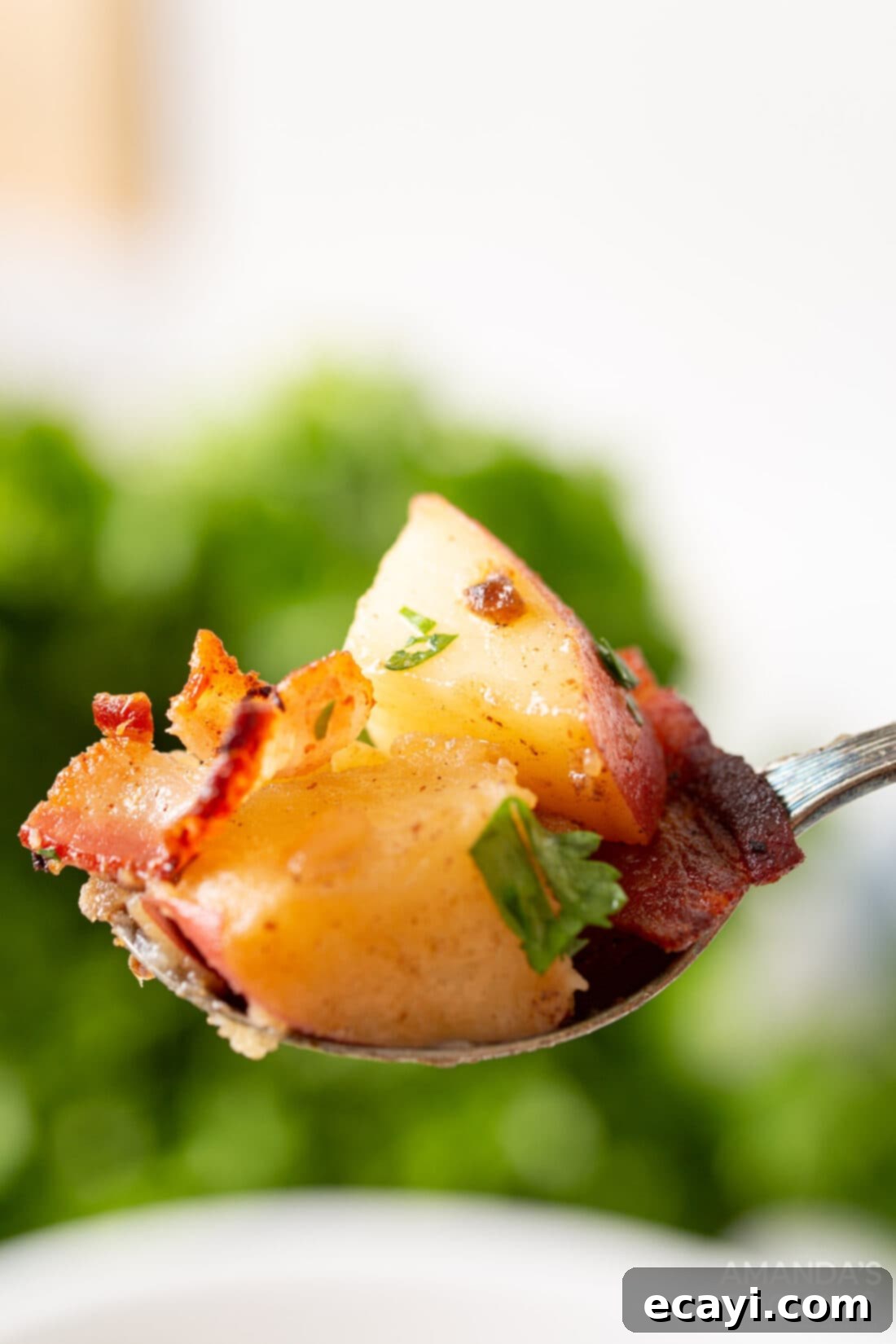
Serving Suggestions for Your German Potato Salad
German potato salad is incredibly versatile and pairs wonderfully with a variety of dishes, making it suitable for any occasion, from casual weeknight dinners to festive holiday spreads and summer barbecues. Its robust, tangy flavor profile acts as a perfect counterpoint to rich meats and complements grilled dishes beautifully. Consider serving it alongside:
- Grilled meats such as succulent grilled chicken breasts, flavorful grilled pork chops, or juicy steaks.
- Classic German fare like air fryer bratwurst, schnitzel, or roasted pork loin.
- Hearty comfort foods like meatloaf or pot roast.
- Perfect for picnics and potlucks, served at room temperature or chilled, where it truly shines as a standout side dish.
Whether you prefer it warm, at room temperature, or chilled, German potato salad is a crowd-pleaser. For a final flourish, add a sprinkle of fresh parsley or chives as a garnish and season with additional salt and freshly ground black pepper to enhance its vibrant flavors.
Explore More Delicious Side Dish Recipes
If you love discovering new and exciting side dishes that elevate your meals, you’re in the right place! Here are a few more fantastic recipes that are sure to become family favorites, offering a range of flavors and textures to complement any main course:
- Amish Macaroni Salad
- Summer Pasta Salad
- Mediterranean Potato Salad
- Tomato Cucumber Salad with Feta
- Roasted Potatoes with Rosemary and Garlic
- Potato Pancakes
I love to bake and cook and share my kitchen experience with all of you! Remembering to come back each day can be tough, that’s why I offer a convenient newsletter every time a new recipe posts. Simply subscribe and start receiving your free daily recipes!
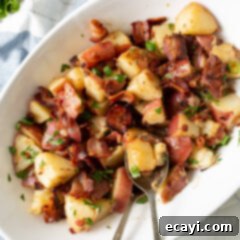
German Potato Salad
IMPORTANT – There are often Frequently Asked Questions within the blog post that you may find helpful. Simply scroll back up to read them!
Print It
Pin It
Rate It
Save ItSaved!
Ingredients
- 2 lb red potatoes
- ½ cup purple onion diced, aka red onion
- 6 strips bacon cut into 1 inch pieces, you can use anywhere between 5-8 strips of bacon
- 2 cloves garlic minced
- ¼ cup apple cider vinegar
- ¼ cup beef broth
- 1 Tbsp dijon mustard
- 2 Tbsp sugar
- ½ tsp salt
- ¼ tsp pepper
Things You’ll Need
-
Large skillet
Before You Begin
- Store in an air tight container kept in the refrigerator for 3-4 days.
Instructions
-
If using baby red potatoes, quarter them leaving the skin on. If using large red potatoes, halve each potato then cut into three equal pieces. Cook the potatoes in a pot of boiling water for 15-20 minutes until fork tender but not mushy.
-
While the potatoes are cooking, use a large skillet to fry the bacon. Set aside on a paper towel lined plate and remove all but two Tablespoons of bacon grease. Add the chopped purple onion to the skillet and cook for 2 minutes before adding the garlic. Stir and allow the garlic to cook for 30 seconds
-
Pour in the apple cider vinegar, broth, mustard, and sugar to the hot skillet and stir.
-
Bring to a simmer for 7 minutes. Remove from heat and toss contents with cooked, drained potatoes.
-
Add the potatoes to a serving bowl topped with the bacon pieces, parsley and/or chives for garnish. Salt and pepper to taste.
Nutrition
The recipes on this blog are tested with a conventional gas oven and gas stovetop. It’s important to note that some ovens, especially as they age, can cook and bake inconsistently. Using an inexpensive oven thermometer can assure you that your oven is truly heating to the proper temperature. If you use a toaster oven or countertop oven, please keep in mind that they may not distribute heat the same as a conventional full sized oven and you may need to adjust your cooking/baking times. In the case of recipes made with a pressure cooker, air fryer, slow cooker, or other appliance, a link to the appliances we use is listed within each respective recipe. For baking recipes where measurements are given by weight, please note that results may not be the same if cups are used instead, and we can’t guarantee success with that method.
